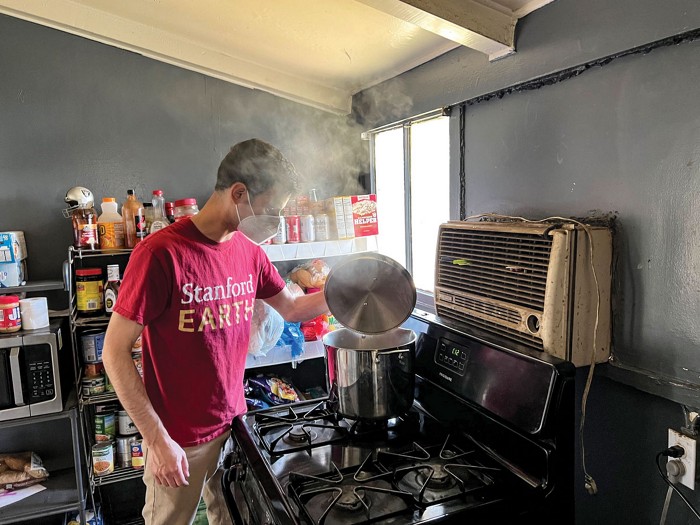Advertisement
Grab your lab coat. Let's get started
Welcome!
Welcome!
Create an account below to get 6 C&EN articles per month, receive newsletters and more - all free.
It seems this is your first time logging in online. Please enter the following information to continue.
As an ACS member you automatically get access to this site. All we need is few more details to create your reading experience.
Not you? Sign in with a different account.
Not you? Sign in with a different account.
ERROR 1
ERROR 1
ERROR 2
ERROR 2
ERROR 2
ERROR 2
ERROR 2
Password and Confirm password must match.
If you have an ACS member number, please enter it here so we can link this account to your membership. (optional)
ERROR 2
ACS values your privacy. By submitting your information, you are gaining access to C&EN and subscribing to our weekly newsletter. We use the information you provide to make your reading experience better, and we will never sell your data to third party members.
Atmospheric Chemistry
Gas stoves could be responsible for 19,000 premature deaths, study finds
Health impacts of gas stoves may also fall disproportionately on low-income households
by Krystal Vasquez
May 7, 2024

According to a new study, gas and propane stoves emit unhealthy amounts of nitrogen dioxide. Regular use of these stoves can increase a household’s annual exposure to NO2 by 4 ppb, or 75% of the long-term exposure limit set by the World Health Organization (WHO) (Sci. Adv. 2024, DOI: 10.1126/sciadv.adm8680).
“In other words, just by using gas stoves regularly, you’re eating up three-quarters of that guideline, which was established to protect public health,” Yannai Kashtan, a PhD candidate at the Stanford Doerr School of Sustainability and lead author of the study, said during a press briefing. Exposure to outdoor sources of NO2, such as vehicle traffic, already frequently push people over that guideline, he added.
In the US, around 38% of households have gas stoves, which create NO2 as the burning natural gas heats nitrogen in the surrounding air. Chronic exposure to nitrogen dioxide has repeatedly been linked to the development and exacerbation of respiratory diseases such as asthma.
Children are at an especially high risk of experiencing these health effects.
The researchers estimate that long-term exposure to the NO2 emitted from gas and propane stoves could be responsible for up to as many as 50,000 pediatric asthma cases in the US. “The full impact may be closer to around 200,000 cases” when benzene and other pollutants emitted by the stoves are considered, Kari Nadeau, chair of the department of environmental health at Harvard T.H. Chan School of Public Health and one of the coauthors of the study, said at the press briefing.
As for adults, “we have calculated that up to 19,000 premature deaths may also be attributed to long-term exposure [to NO2] from gas stoves,” Nadeau added. “That is also probably a conservative number.”
To determine how much nitrogen dioxide gas and propane stoves produce, the researchers measured concentrations of the pollutant before, during, and for several hours after the stoves were used in more than 100 houses and apartments across five US states. They then estimated the residents’ exposure by putting those measurements into an indoor air quality model that predicts how pollution moves through a home.
“The pollution doesn’t stay in the kitchen,” Rob Jackson, a professor of Earth system science at Stanford’s Doerr School and the study’s principal investigator, said during the press briefing. “The pollution we measured travels from the kitchen to distant bedrooms and travels far and fast.”
In a subset of the homes studied, the NO2 levels measured in bedrooms surpassed the hourly limits set by both the WHO and US Environmental Protection Agency within 30 min of turning on a stove or oven. Concentrations often remained above those public health benchmarks for hours, Jackson said.
The researchers also found that the health impacts of gas and propane stoves may fall disproportionately on those living in homes of less than 75 m2. According to the study, residents of such homes are exposed to an extra 8.6 ppb of NO2 per year—four times as much as people living in houses of more than 280 m2.
“Because of historical and present-day discrimination, this disparity and exposure by housing size manifests as disparities and exposure by income and race and ethnic group,” Kashtan said. In particular, “Indigenous, Black, and Latino communities are exposed to more pollution from stoves” than the national average.
The American Gas Association (AGA), a trade group, calls the study misleading and unsupported. “The data presented here clearly does not support any linkages between gas stoves and childhood asthma or adult mortality,” AGA president Karen Harbert says in a press release. At least two earlier studies the researchers cited, including a meta-analysis commissioned and funded by the WHO, “contradict the conclusions they have presented,” Harbert says.
In a joint email response, Jackson and Kashtan say that “fifty years of research tie gas stoves to nitrogen dioxide (NO2) emissions and increased asthma.” This research includes the WHO-funded meta-analysis, which found a positive association between gas stoves and pediatric asthma (Lancet Respir. Med. 2024, DOI: 10.1016/S2213-2600(23)00427-7).
In addition, “decades of research have established that nitrogen dioxide (NO2) causes asthma,” regardless of the pollution source, they write. “It should not be controversial, therefore, that NO2 coming from your stove causes asthma, too.





Join the conversation
Contact the reporter
Submit a Letter to the Editor for publication
Engage with us on Twitter